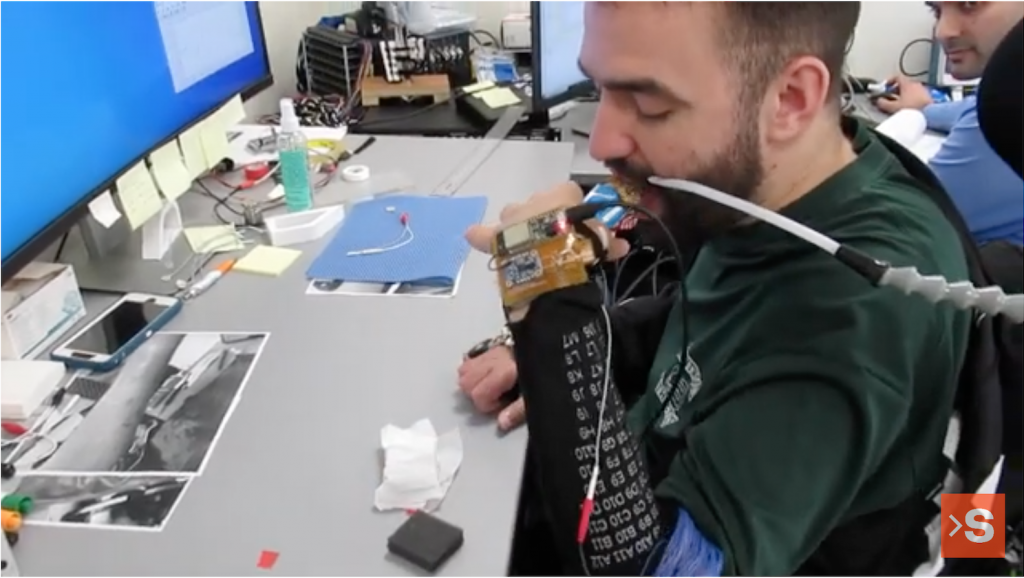
In a YouTube video, Luke Tynan, who was paralyzed in 2017 by a spinal cord injury, is able to use his arm to eat a candy bar. (Source: IEEE Spectrum)
AI Brain-Computer Interface Restores Feeling, Movement in Paralyzed Man
For decades, science fiction writer have entertained us with tales of human beings becoming cyborgs. There have been films and comic books that thrilled us. Usually, the cyborg story involves superhero-level fighting because a human has now become part machine. Implanted with robotic body parts the hero or the villain has become stronger and faster than regular humans.
That cyborg is science fiction. But a recent announcement shows how a sort of cyborg success occurred in the real world.
Implanted Chips
In what seems like a weekly headline regarding AI and its effect on the medical world, futurism.com has a story that is truly miraculous in its scope. It recounts how 45-year-old Keith Thomas, who was paralyzed from the neck down after diving into a swimming pool, is now able to move and feel his arms. A first-of-its-kind clinical trial gave him the ability to use his arms for the first time in three years.
Thomas, who lives with quadriplegia, was the first patient to receive what his doctors are calling a double neural bypass, a new bioelectrical therapy pioneered at Northwell Health’s Feinstein Institutes for Medical Research. Led by Chad Bouton, a professor at Northwell’s Institute of Bioelectronic Medicine, the experimental new procedure involves a combination of AI, brain-computer interface (BCI) implants, external computers, and non-invasive wearable tech.
Like a coronary bypass surgery creates a detour for your heart to pump blood around an obstacle, a neural bypass uses a combination of machine learning and electrical signaling to reroute an individual’s neural signals, avoiding whatever barrier is preventing them from making it where they’re supposed to go. A double neural bypass, then, reroutes the signal in just one but two places: in this case, the areas responsible for movement and touch.
“It’s a very challenging problem,” said Bouton, who’s also the founder and CEO of a biotech firm called Neuvotion, over a video call. “You’re looking at these complex electrical patterns in the brain, and you’re trying to make sense out of the patterns and extract information from them. We want to know when someone’s thinking about moving their hand, or moving their fingers, and we want to be able to then channel those thoughts into something useful.”
Thought-Driven Therapy
The article goes deeply into the process of this experimental operation. His doctors report how grueling this recovery process is. Thomas had endured months of pre-op MRIs and other testing by the researchers.
The operation took 15 hours and Thomas was awake through part of it so he could continue to communicate with doctors who were operating on his brain.
Doctors developed a strategy to implant a total of five BCI chips: two at the area of the brain that presides over movement, and three at the region responsible for touch and feeling in the fingers. The chips pass decoded bioelectrical messages to the computer, which then sends electric signals to a series of electrode-laden patches placed across Thomas’ spine and forearms. Finally, a handful of infinitesimal sensors placed on Thomas’ fingertips and palms send touch and pressure data back up to the sensory region of Thomas’ brain.
“Every time he thinks about moving and feeling, we actually send another signal to the spinal cord, and that supercharges the spinal cord,” said Bouton. “It tries to strengthen connections.”
This is fantastic news for the millions of people plagued by paralysis and various other brain injuries that make life so difficult.
This story will probably bring tears to your eyes. It is truly miraculous how AI has helped Thomas accomplish movement and sensation in his limbs.
In the four months since the procedure, Thomas has regained full strength in both arms, even a 100 percent recovery in his right arm. But most excitingly, Thomas has started to experience natural recovery in his forearm and wrist — meaning that the therapy might have kickstarted his nervous system’s innate healing processes.
It is truly an incredible success story written by Maggie Harrison. What was once thought to be medically impossible, is now a medical reality through the addition of AI and an amazing group of doctors, scientists, and researchers.
read more at futurism.com







Leave A Comment